Modelling of the Guillotine Cutting Process by Means of a Symmetrical Blade with the Defined Geometry
Abstract
1. Introduction
2. Materials and Methods
2.1. Mechanical Properties of the Material Being Cut
2.2. Modelling of the Cutting Process
- The knife and the top sheet being cut,
- The knife and the bottom sheet being cut,
- The knife and the worktable,
- The pressure beam and the top sheet being cut,
- The top sheet being cut and the bottom sheet being cut,
- The second sheet being cut and the worktable.
3. Results and Discussion
- Defects on a blade of a cutting tool, and
- Defects on a cut surface of a sheet being cut.
- Build up edge, and
- Dent in various shapes (e.g., semicircle).
- Edge bending,
- Vertical scratches, and
- Deep vertical grooves or craters.
3.1. Numerical Investigations of a Bundle of Metal Sheets Being Cut
- Deflection of the edge bending of the sheet being cut,
- Random occurrence of deep vertical scratches in the shape of craters, and
- Random occurrence of burrs.
3.2. The Scanning Microscope Observation of a Symmetrical Cutting Tool
3.3. The Scanning Microscope Observation of Surfaces of Sheets Being Cut
3.4. Comparison of the Numerical and Experimental Investigations
4. Conclusions
- The first sheet in a bundle can be quite easily cut off, but the conditions for the sheet located underneath in a bundle are slightly harder, because the plastic deformation arisen in the first sheet influences the second one (located on the bottom of a bundle),
- The plastic zone of sheets being cut equals circa 1/5 of the total height of a sheet, but the plastic zone for the second sheet (located on the bottom in a bundle) is connected with a slightly higher number of defects caused by higher shearing stresses, which means that the cutting conditions might be determined as harder,
- The brittle zone of sheets being cut equals circa 4/5 of the total height of a sheet, but the brittle zone for the second sheet (located on the bottom) is connected with a slightly higher number of brittle walls with no micro-voids caused by a higher equivalent Huber–Mises stresses, which means that the cutting conditions can be described as harder, too,
- The high values of equivalent Huber–Mises stresses and corresponding to them strains are in sheets situated on the cutting line directly underneath the tip of a blade,
- The stresses and strains located along the cutting line are slightly higher in the bottom sheet in comparison to the top one,
- The failure mechanisms concerning the surfaces of sheets being cut exerts influence on:
- Shearing stresses, which are responsible for causing undesired various damages especially in the plastic region such as dimples, micro voids, scratches, etc., in the early phase of the cutting process,
- Tensile stresses, which are responsible for attaining smooth surfaces practically without defects except those observed in shape of numerous brittle walls due to ripping of sheets being cut into separate parts in the final phase of the cutting process,
- The size of the plastic region responsible for most damages is strongly dependent on the geometry of the blade of a cutting tool. It is possible to influence the reduction of undesired plastic region as well as maximisation of the highly desired brittle one by changing the geometry of the blade of a cutting tool.
Funding
Acknowledgments
Conflicts of Interest
Appendix A


References
- Graham, T.S. Cutting Tool Technology. Industrial Handbook; Springer: London, UK, 2008. [Google Scholar]
- Show, M.C. Metal Cutting Principles; Oxford University Press: New York, NY, USA, 2005. [Google Scholar]
- Flizikowski, J.B.; Kruszelnicka, W.; Tomporowski, A.; Mrozinski, A. A study of operating parameters of a roller mill with a new design. In Proceedings of the AIP Conference Proceedings, Bydgoszcz, Poland, 23 November 2018. [Google Scholar] [CrossRef]
- Macko, M.; Flizikowski, J.; Szczepański, Z.; Tyszczuk, K.; Śmigielski, G.; Mroziński, A.; Czerniak, J.; Tomporowski, A. CAD/CAE applications in mill’s design and investigation. In Proceedings of the 13th International Scientific Conference: Computer Aided Engineering, Polanica Zdrój, Poland, 22–25 June 2016; Rusiński, E., Pietrusiak, D., Eds.; Springer: Cham, Switzerland, 2017; pp. 343–351. [Google Scholar]
- Gembalczyk, G.; Duda, S.; Kciuk, S.; Gąsiorek, D.; Mężyk, A. Mechatronic treadmill for gait reeducation with control algorithm of treadmill speed adaptation. Proc. Inst. Mech. Eng. Part C J. Mech. Eng. Sci. 2018, 233, 2239–2247. [Google Scholar] [CrossRef]
- Mężyk, A.; Klein, W.; Pawlak, M.; Kania, J. The identification of the vibration control system parameters designed for continuous miner machines. Int. J. Non-Linear Mech. 2017, 91, 181–188. [Google Scholar] [CrossRef]
- Weresa, E.; Seweryn, A.; Szusta, J.; Rak, Z. Fatigue testing of transmission gear. Ekspolatacja i Niezawodn. Maint. Reliab. 2015, 17, 207–214. [Google Scholar] [CrossRef][Green Version]
- Wrobel, G.; Szymiczek, M.; Kaczmarczyk, J. Influence of the Structure and Number of Reinforcement Layers on the Stress State in the Shells of Tanks and Pressure Pipes. Mech. Compos. Mater. 2017, 53, 165–178. [Google Scholar] [CrossRef]
- Ogierman, W.; Kokot, G. Determination of Local Strain Distribution at the Level of the Constituents of Particle Reinforced Composite: An Experimental and Numerical Study. Materials 2020, 13, 3889. [Google Scholar] [CrossRef]
- Duda, S.; Kciuk, S.; Gniłka, J.; Kaszyca, T. Numerical investigations of the influence of seismic vibrations on the transformer structure. In Proceedings of the 14th International Scientific Conference: Computer Aided Engineering, Wrocław, Poland, 22–23 June 2018; Rusiński, E., Pietrusiak, D., Eds.; CAE 2018; Springer: Cham, Switzerland, 2019; pp. 163–174. [Google Scholar] [CrossRef]
- Nouari, M.; Makich, H. On the physics of machining titanium alloys: Interactions between cutting parameters, microstructure and tool wear. Metals 2014, 4, 335–338. [Google Scholar] [CrossRef]
- Razak, N.H.; Chen, Z.W.; Pasang, T. Effects of Increasing Feed Rate on Tool Deterioration and Cutting Force during End Milling of 718Plus Superalloy Using Cemented Tungsten Carbide Tool. Metals 2017, 7, 441. [Google Scholar] [CrossRef]
- Koklu, U.; Basmaci, G. Evaluation of Tool Path Strategy and Cooling Condition Effects on the Cutting Force and Surface Quality in Micromilling Operations. Metals 2017, 7, 426. [Google Scholar] [CrossRef]
- Haddag, B.; Atlati, S.; Nouari, M.; Moufki, A. Dry Machining Aeronautical Aluminum Alloy AA2024-T351: Analysis of Cutting Forces, Chip Segmentation and Built-Up Edge Formation. Metals 2016, 6, 197. [Google Scholar] [CrossRef]
- González, H.; Pereira, O.M.; Fernández-Valdivielso, A.; LaCalle, L.; Calleja, A. Comparison of Flank Super Abrasive Machining vs. Flank Milling on Inconel® 718 Surfaces. Materials 2018, 11, 1638. [Google Scholar] [CrossRef]
- Lamikiz, A.; De Lacalle, L.N.L.; Sánchez, J.A.; Bravo, U.; Lamikiz, A. Calculation Of The Specific Cutting Coefficients And Geometrical Aspects In Sculptured Surface Machining. Mach. Sci. Technol. 2005, 9, 411–436. [Google Scholar] [CrossRef]
- Kaczmarczyk, J.; Kozlowska, A.; Grajcar, A.; Sławski, S. Modelling and Microstructural Aspects of Ultra-Thin Sheet Metal Bundle Cutting. Metals 2019, 9, 162. [Google Scholar] [CrossRef]
- Gasiorek, D.; Baranowski, P.; Malachowski, J.; Mazurkiewicz, L.; Wiercigroch, M. Modelling of guillotine cutting of multi-layered aluminum sheets. J. Manuf. Process. 2018, 34, 374–388. [Google Scholar] [CrossRef]
- Kaczmarczyk, J. Numerical simulations of preliminary state of stress in bundles of metal sheets on the guillotine. Arch. Mater. Sci. Eng. 2017, 85, 14–23. [Google Scholar] [CrossRef]
- Kaczmarczyk, J.; Gąsiorek, D.; Mężyk, A.; Skibniewski, A. Connection between the defect shape and stresses which cause it in the bundle of sheets being cut on guillotines. Model. Optim. Phys. Syst. 2007, 6, 81–84. [Google Scholar]
- Kaczmarczyk, J. Force Measurement in the Guillotine Tool of a Prototypical Guillotine. In Depth-Solutions with Graphical System Design in Eastern Europe; National Instruments: Warsaw, Poland, 2012; pp. 63–65. [Google Scholar]
- Bohdal, Ł. Application of a SPH Coupled FEM Method for Simulation of Trimming of Aluminum Autobody Sheet. Acta Mech. Autom. 2016, 10, 56–61. [Google Scholar] [CrossRef]
- Kaczmarczyk, J.; Grajcar, A. Numerical simulation and experimental investigation of cold-rolled steel cutting. Materials 2018, 11, 1263. [Google Scholar] [CrossRef]
- Kaczmarczyk, J. Modelling of Guillotine Cutting of a Cold-Rolled Steel Sheet. Materials 2019, 12, 2954. [Google Scholar] [CrossRef]
- Fedeliński, P. Dynamically loaded branched and intersecting cracks. J. Civ. Eng. 2017, 34, 17–26. [Google Scholar] [CrossRef][Green Version]
- Paggi, M. Crack propagation in honeycomb cellular materials: A computational approach. Metals 2012, 2, 65–78. [Google Scholar] [CrossRef]
- Cho, J.R. A numerical evaluation of SIFs of 2-D functionally graded materials by enriched natural element method. Appl. Sci. 2019, 9, 3581. [Google Scholar] [CrossRef]
- Perez, N. Fracture Mechanics; Kluwer Academic Publishers: Boston, MA, USA, 2004. [Google Scholar]
- Xiong, X.; Xiao, Q. Meso-scale simulation of concrete based on fracture and interaction behavior. Appl. Sci. 2019, 9, 2986. [Google Scholar] [CrossRef]
- Bhatti, M.A. Practical Optimization Methods; Springer: New York, NY, USA, 2000. [Google Scholar]
- Rothwell, A. Optimisation Methods in Structural Design; Springer International Publishing AG: Delft, The Netherlands, 2017. [Google Scholar]
- Goldberg, D.E. Genetic Algorithms in Search, Optimization, and Machine Learning; Addison-Wesley Publishing Company, Inc.: New York, NY, USA, 1989. [Google Scholar]
- Michalewicz, Z. Genetic Algorithms + Data Structures = Evolution Programs; Springer: Berlin/Heidelberg, Germany, 1996. [Google Scholar]
- Gembalczyk, G.; Duda, S.; Świtoński, E. Computational optimization and applications of control system for mechatronic treadmill with body weight support system. J. Theor. Appl. Mech. 2018, 58, 1179–1191. [Google Scholar] [CrossRef]
- Mężyk, A.; Pawlak, M.; Klein, W.; Kania, J. Modeling and optimization of resonance characteristics of complex machinery system under dynamic load. Arch. Appl. Mech. 2015, 85, 1383–1398. [Google Scholar] [CrossRef][Green Version]
- Arslanov, M.M. A polynomial algorithm for one problem of guillotine cutting. Oper. Res. Lett. 2007, 35, 636–644. [Google Scholar] [CrossRef]
- Alvarez-Valdés, R.; Parajón, A.; Tamarit, J.M. A tabu search algorithm for large-scale guillotine (un)constrained two-dimensional cutting problems. Comput. Oper. Res. 2002, 29, 925–947. [Google Scholar] [CrossRef]
- Tiwari, S.; Chakraborti, N. Multi-objective optimization of a two-dimensional cutting problem using genetic algorithms. J. Mater. Process. Technol. 2006, 173, 384–393. [Google Scholar] [CrossRef]
- Bathe, K.-J.; Chaudhary, A. A solution method for planar and axisymmetric contact problems. Int. J. Numer. Methods Eng. 1985, 21, 65–88. [Google Scholar] [CrossRef]
- Belytschko, T.; Liu, W.K.; Moran, B.; Elkhodary, K.I. Nonlinear Finite Elements for Continua and Structure; John Wiley & Sons, Ltd.: Southern Gate, CA, USA, 2014. [Google Scholar]
- Mohammadi, S. Discontinuum Mechanics Using Finite and Discrete Elements; WIT Press Southampton: Boston, MA, USA, 2003. [Google Scholar]
- Hughes, T.J.R. The Finite Element Method. Linear Static and Dynamic Finite Element Analysis; Manufactured in the United States by RR Donnelley: Chicago, IL, USA, 2016. [Google Scholar]
- Zienkiewicz, O.C.; Taylor, R.L. The Finite Element Method, Solid Mechanics; Butterworth-Heinemann: Oxford, UK, 2000. [Google Scholar]
- Livermore Software Technology Corporation. LS-DYNA Keyword User’s Manual; Livermore Software Technology Corporation: Livermore, CA, USA, 2017. [Google Scholar]
- Timoshenko, S.P.; Goodier, J.N. Theory of Elasticity; McGraw-Hill Education: New York, NY, USA, 2017. [Google Scholar]
- Callister, W.D. Fundamentals of Materials Science and Engineering; John Wiley & Sons: Hoboken, NJ, USA, 2001. [Google Scholar]
- Beer, F.P.; Jonhston, E.R.; Mazurek, D.F.; Cornwell, P.J.; Eisenberg, E.R. Vector Mechanics for Engineers; Mc Graw-Hill Book Company: New York, NY, USA, 1984. [Google Scholar]
- ASM International. ASM Handbook. Volume 12: Fractography; ASM International: Cleveland, OH, USA, 1987. [Google Scholar]
- Salvati, E.; Korsunsky, A.M. An Analysis of Macro- and Micro-scale Residual Stresses of Type I, II and III using FIB-DIC Micro-ring-core Milling and Crystal Plasticity FE Modelling. Int. J. Plast. 2017, 98, 123–138. [Google Scholar] [CrossRef]


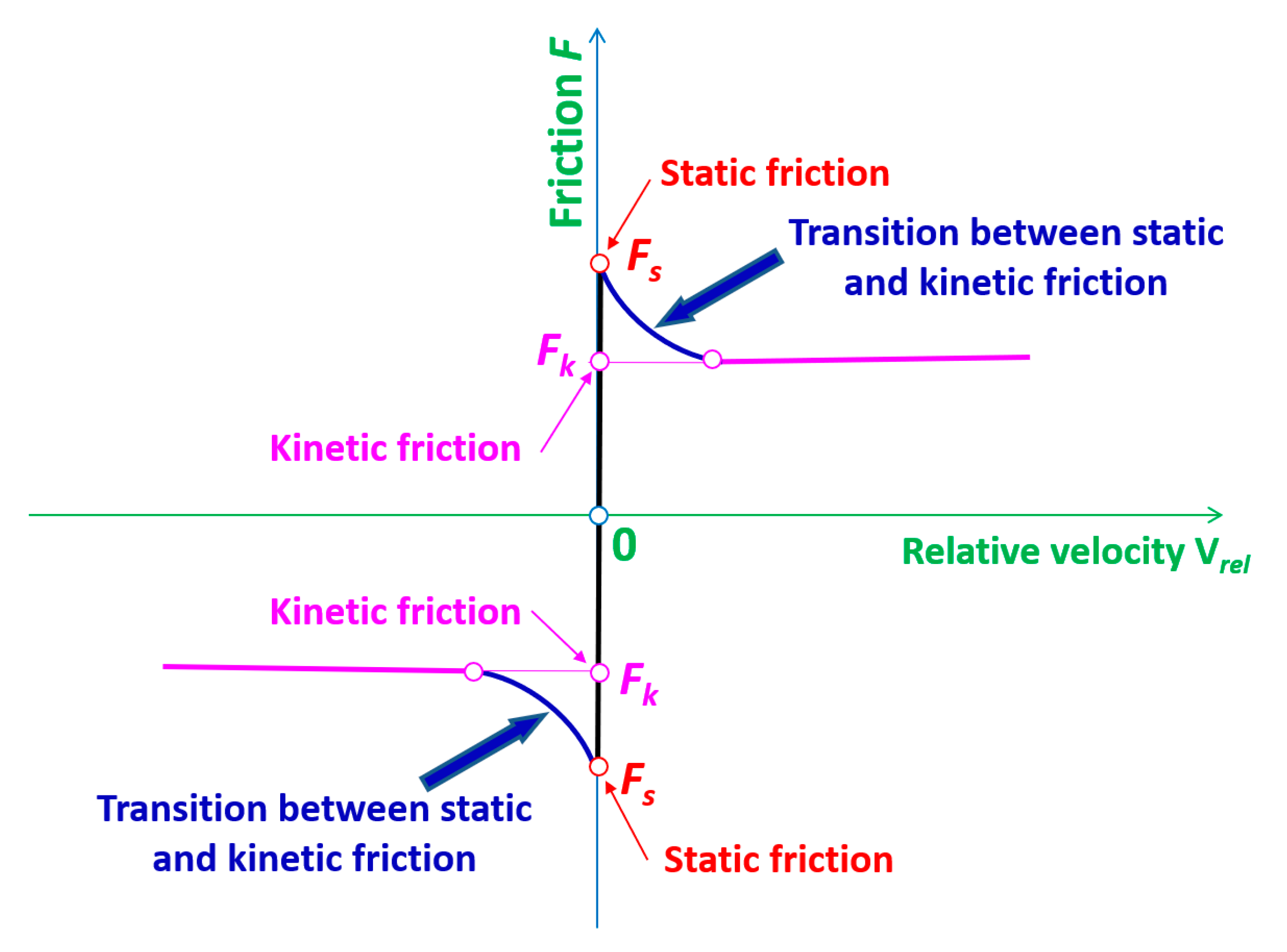
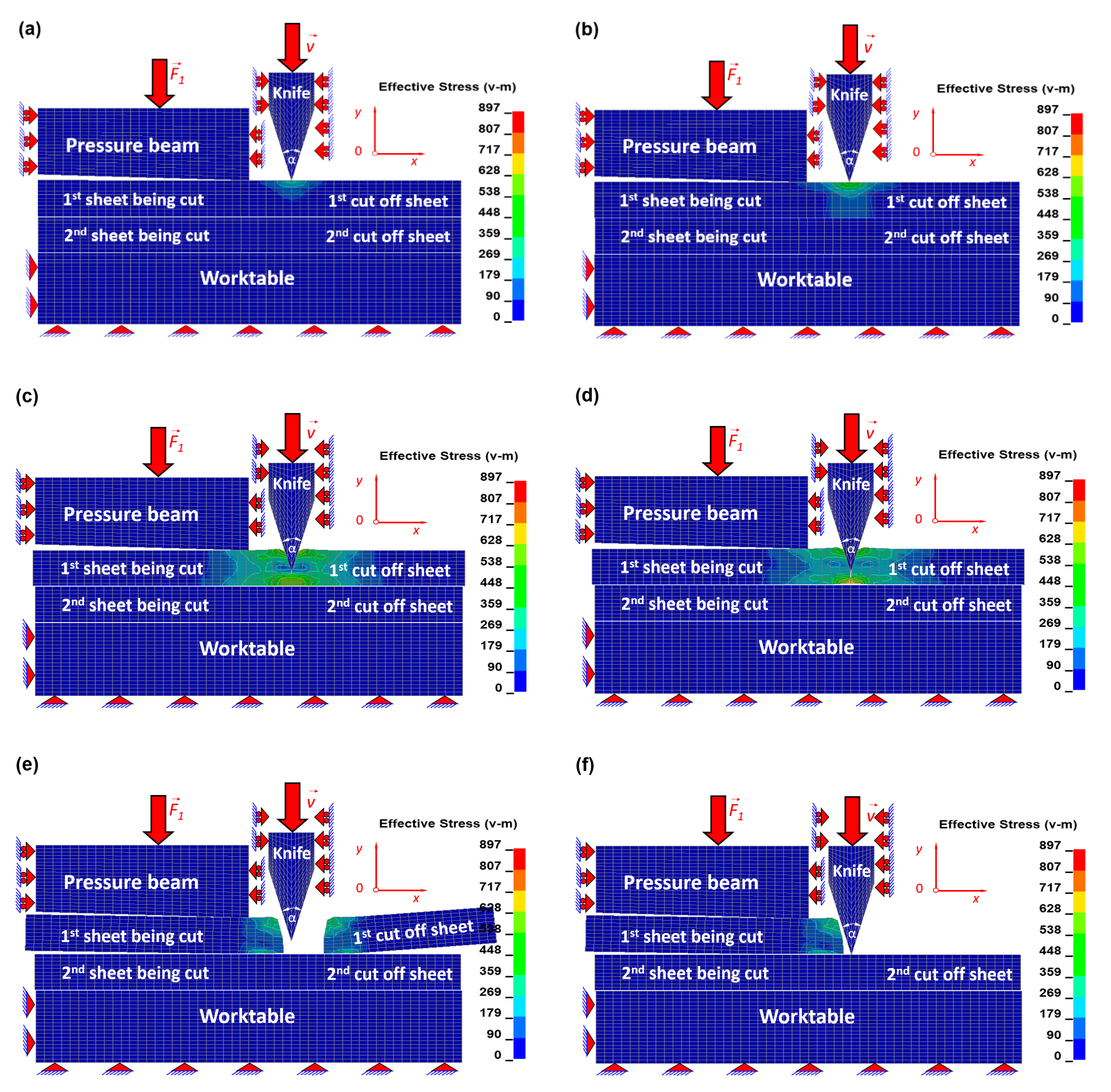
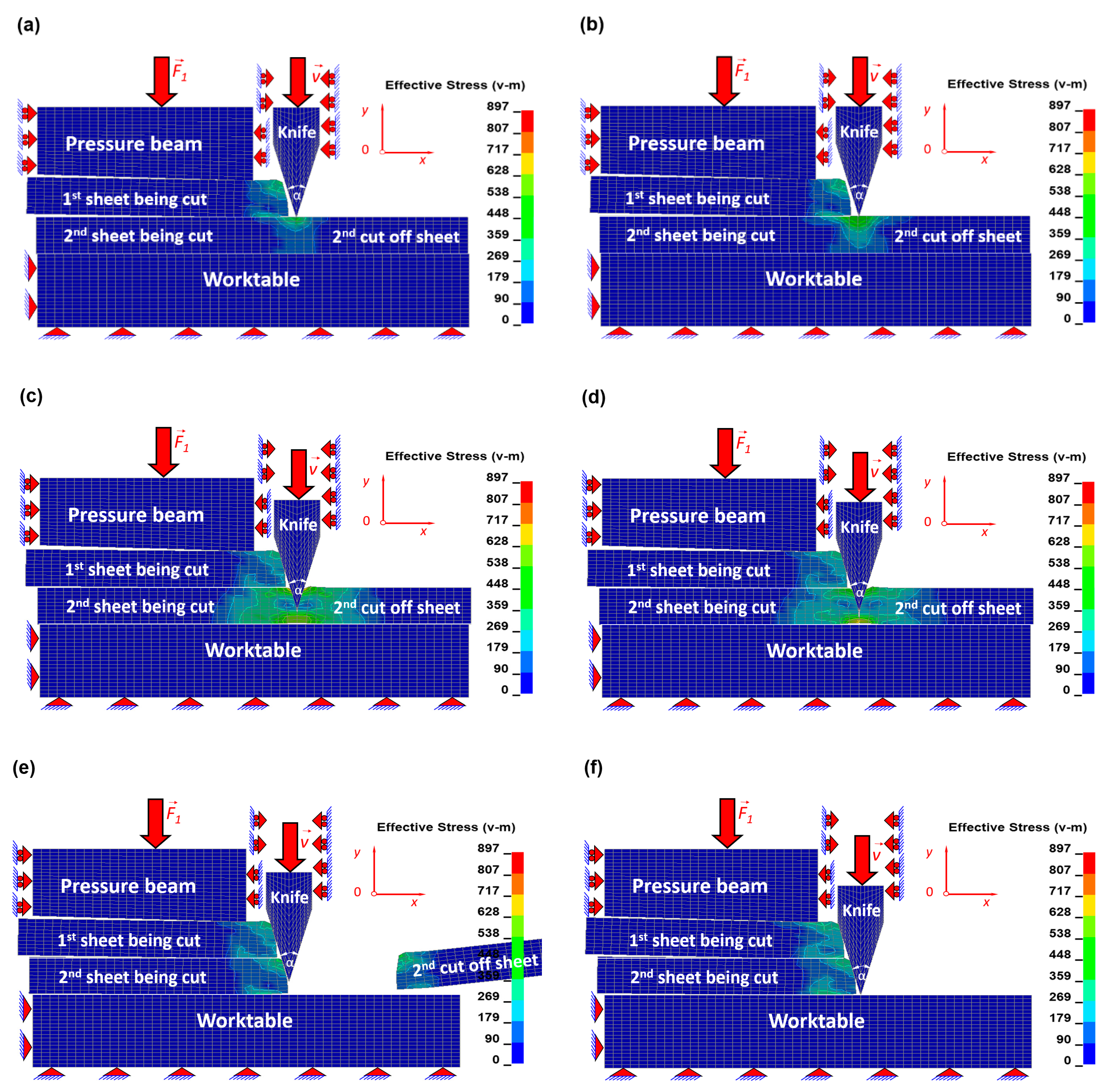



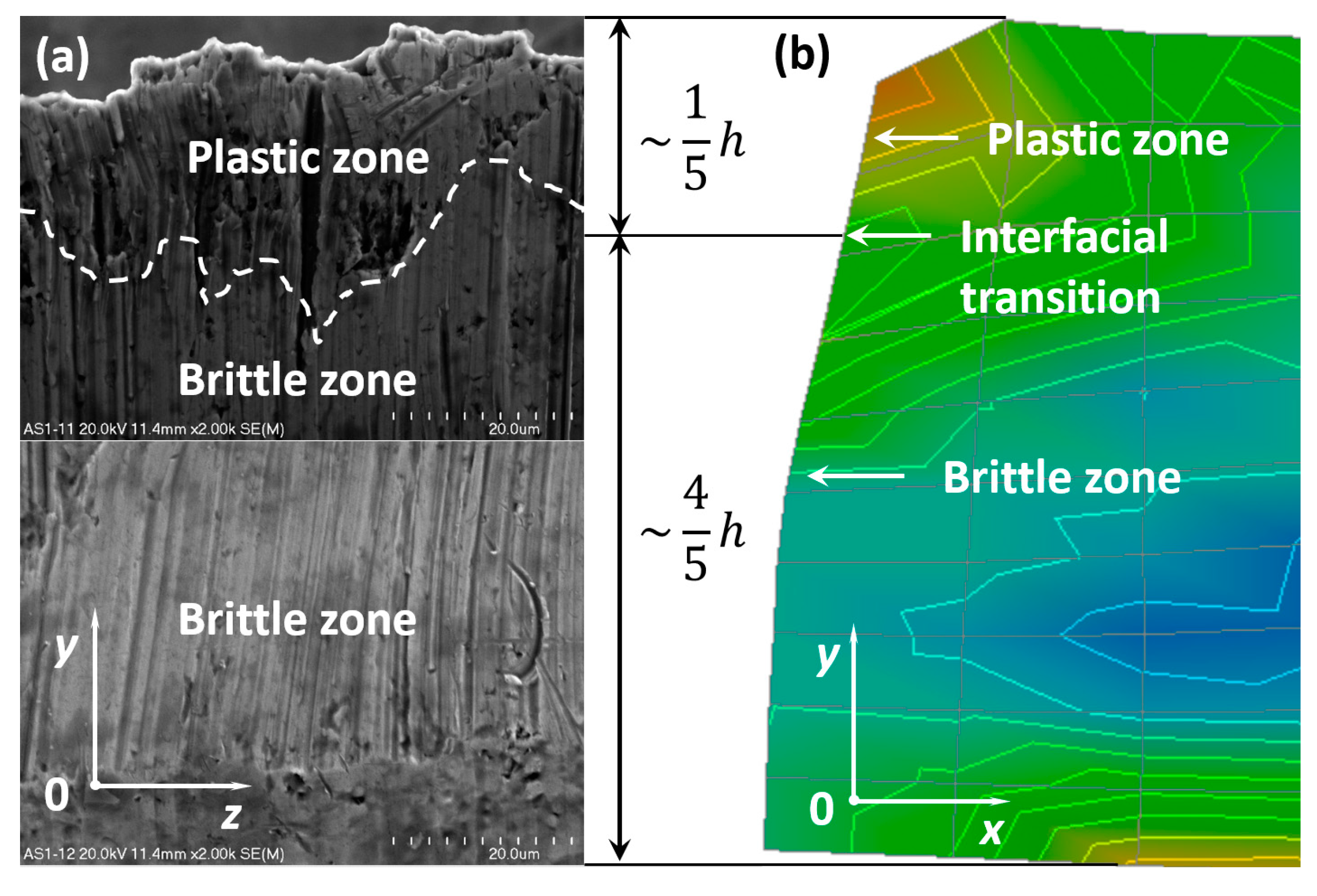
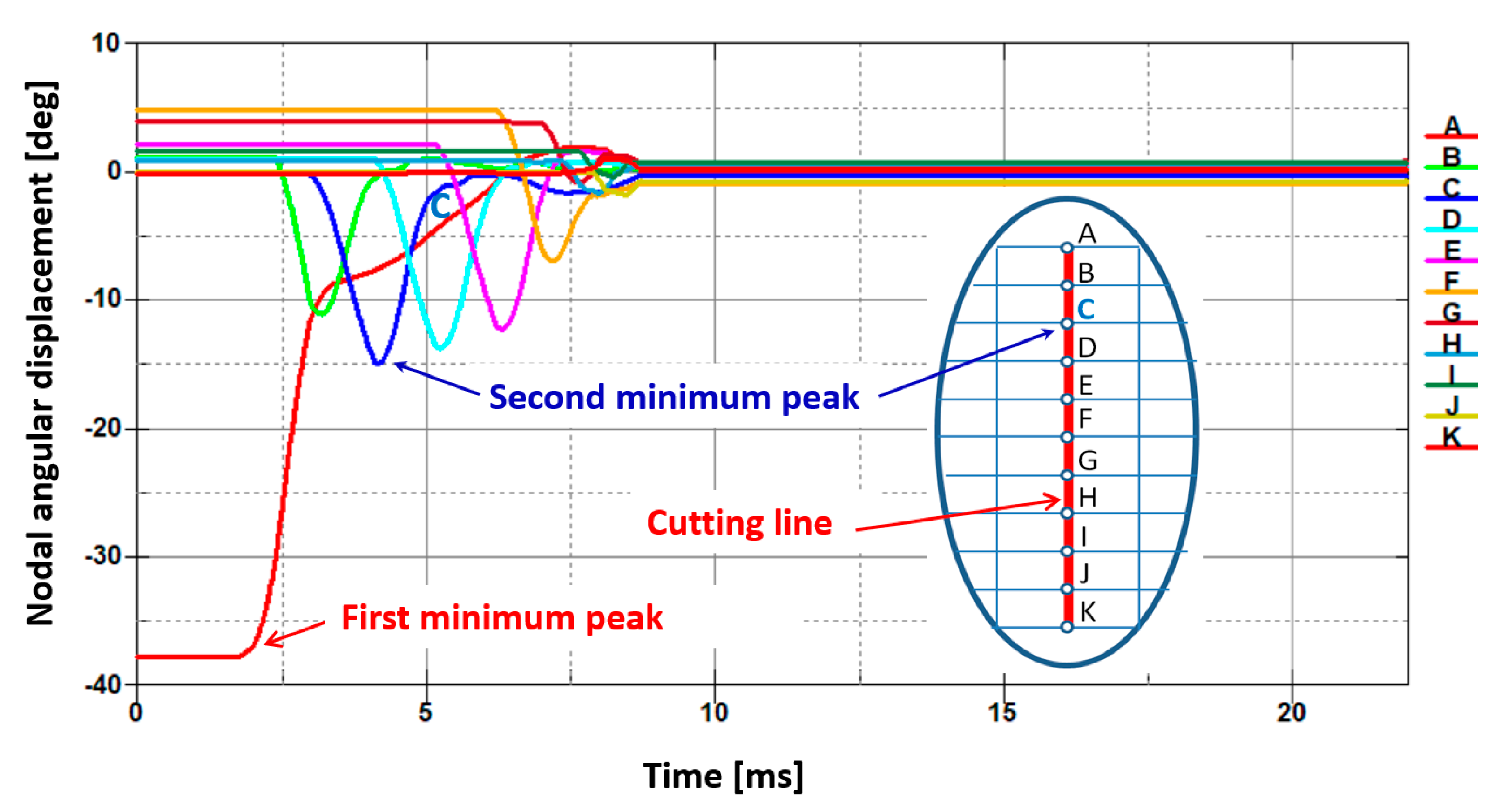


| No | Name of the Material Properties | Symbol | Value [17,23,46] |
|---|---|---|---|
| 1. | Young’s modulus | E | 205 GPa |
| 2. | Poisson’s ratio | ν | 0.28 |
| 3. | Kirchhoff’s modulus | G | 80 GPa |
| 4. | Tangent modulus | ET | 0.867 GPa |
| 5. | Failure strain | εf | 0.15 mm/mm |
| 6. | Yield strength | Re | 0.51 GPa |
| 7. | Ultimate tensile strength | Ru | 0.64 GPa |
| No | Name of the Part | Kind of Part | Number of Nodes | Number of Finite Elements |
|---|---|---|---|---|
| 1. | Cutting tool | Rigid | 208 | 180 |
| 2. | First metal sheet in a bundle | Deformable | 572 | 500 |
| 3. | Second metal sheet in a bundle | Deformable | 572 | 500 |
| 4. | Pressure beam | Rigid | 546 | 500 |
| 5. | Immovable worktable | Rigid | 1071 | 1000 |
| Total number in whole model | 2969 | 2680 | ||
| No | Dimension/Part | Length [mm] | Width [mm] | Thickness [mm] |
|---|---|---|---|---|
| 1. | Cutting tool | 30 | 35 | 11 |
| 2. | Sheet being cut | 2.0 | 12.5 | 0.1 |
Publisher’s Note: MDPI stays neutral with regard to jurisdictional claims in published maps and institutional affiliations. |
© 2020 by the author. Licensee MDPI, Basel, Switzerland. This article is an open access article distributed under the terms and conditions of the Creative Commons Attribution (CC BY) license (http://creativecommons.org/licenses/by/4.0/).
Share and Cite
Kaczmarczyk, J. Modelling of the Guillotine Cutting Process by Means of a Symmetrical Blade with the Defined Geometry. Materials 2020, 13, 5404. https://doi.org/10.3390/ma13235404
Kaczmarczyk J. Modelling of the Guillotine Cutting Process by Means of a Symmetrical Blade with the Defined Geometry. Materials. 2020; 13(23):5404. https://doi.org/10.3390/ma13235404
Chicago/Turabian StyleKaczmarczyk, Jarosław. 2020. "Modelling of the Guillotine Cutting Process by Means of a Symmetrical Blade with the Defined Geometry" Materials 13, no. 23: 5404. https://doi.org/10.3390/ma13235404
APA StyleKaczmarczyk, J. (2020). Modelling of the Guillotine Cutting Process by Means of a Symmetrical Blade with the Defined Geometry. Materials, 13(23), 5404. https://doi.org/10.3390/ma13235404





